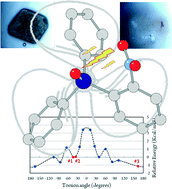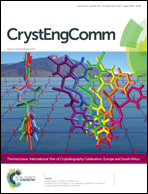The polymorphism of a triarylphosphine oxide: a case of missing isomers†
Abstract
An experimental and computational study of the polymorphism of o-nitrophenyldiphenylphosphine oxide (1) has been carried out. Two polymorphs of 1 have been obtained after a comprehensive screening procedure and their structures have been determined by single crystal diffraction. Both forms present the same racemic mixture of the Ps and Ms enantiomers, where NO2 is in a syn conformation relative to the PO group, thus resulting in the presence of a short PO⋯O2N contact (ca. 2.97 Å). The anti conformation has not been found in any of these polymorphs, thus suggesting the attractive nature of the PO⋯O2N intramolecular interaction. However, MP2 computations on various model systems led to the conclusion that this interaction is energetically destabilizing. An energy analysis of all the symmetry-unique pairs found within the first-nearest neighbour of the experimental polymorphs (all with a syn conformation), and of their corresponding (non-observed) anti conformations, reveals a slightly higher stability of the former. Therefore, if the crystallization of both polymorphs of 1 was only dominated by the energetics of this molecule, the syn and anti conformations should both be present in the crystals. The absence of the latter suggests that the final outcome of this crystallization is not solely determined by the 1⋯1 intermolecular interactions. Instead, 1–solvent interactions, the presence of nucleation-driving centres, for instance, in the container–solution interface, and kinetic factors of the nucleation process could also be relevant or play a leading role.

- This article is part of the themed collection: International Year of Crystallography Celebration: Europe and South Africa

 Please wait while we load your content...
Please wait while we load your content...